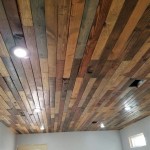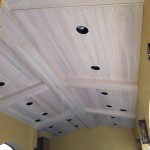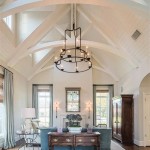Can Walls and Ceilings Be Painted the Same Color? A Comprehensive Guide
The question of whether to paint walls and ceilings the same color is a common one in interior design and home improvement projects. While traditionally ceilings are painted white or a lighter shade than the walls, there are circumstances where using the same color on both surfaces can be a viable and even desirable design choice. This article will explore the various factors to consider when deciding whether or not to adopt this approach, examining the potential benefits, drawbacks, and specific situations where it might be particularly effective.
The decision hinges on understanding the impact of color on perceived space, lighting conditions, architectural features, and personal aesthetic preferences. A uniform color scheme can create a sense of continuity and cohesion, but it can also flatten a room if not executed carefully. Understanding the nuances of color theory and the principles of interior design is crucial for achieving a satisfactory outcome.
Ultimately, there is no right or wrong answer to this question. The appropriateness of painting walls and ceilings the same color depends entirely on the specific context of the space and the desired aesthetic effect. This article aims to provide a comprehensive understanding of the considerations involved, empowering individuals to make informed decisions about their painting projects.
Creating a Cohesive and Spacious Feel
One of the primary benefits of painting walls and ceilings the same color is the creation of a unified and continuous space. This technique can be particularly effective in smaller rooms, as it blurs the lines between the walls and the ceiling, making the room appear larger and more open. By eliminating the visual interruption of a contrasting ceiling, the eye is allowed to travel seamlessly around the room, enhancing the sense of spaciousness.
This approach can also be beneficial in rooms with low ceilings. A contrasting ceiling color can emphasize the lack of height, making the room feel cramped. Painting both surfaces the same color can visually lift the ceiling, creating a more comfortable and airy atmosphere. However, the specific shade chosen plays a critical role. Too dark a color can still overwhelm a small space, regardless of the uniformity. Lighter, more neutral tones tend to be most effective in maximizing the perceived size of a room.
Furthermore, a consistent color scheme can promote a sense of calm and tranquility. The absence of visual contrast can be particularly appealing in bedrooms or other spaces where relaxation is paramount. This uniform approach can also simplify the design process, as it eliminates the need to coordinate separate colors for the walls and ceiling. This streamlined approach can save time and effort, particularly for DIY projects.
However, it is essential to consider the existing architectural details of the room. If the room has intricate moldings, cornices, or other decorative elements, painting them the same color as the walls and ceiling can diminish their visual impact. In such cases, a contrasting color might be preferred to highlight these features and add visual interest. The decision should be based on whether the goal is to emphasize or minimize these architectural details.
The Impact of Lighting on a Uniform Color Scheme
Lighting is a crucial factor to consider when deciding whether to paint walls and ceilings the same color. Natural light, artificial light, and the overall direction and intensity of light will all influence how the color appears in the room. A color that looks beautiful in the morning sunlight might appear drab and lifeless under artificial light in the evening.
In rooms with abundant natural light, a uniform color scheme can be particularly effective. The natural light will help to illuminate the space and prevent the color from feeling too heavy or overwhelming. However, it is important to consider the direction the room faces. A north-facing room, which receives less direct sunlight, might benefit from a lighter color to maximize brightness, even if the walls and ceiling are painted the same shade. Similarly, a south-facing room, which receives intense sunlight, might be able to handle a slightly darker or more saturated color.
Artificial lighting also plays a significant role. The type of light bulbs used, the placement of light fixtures, and the overall lighting scheme will all affect the appearance of the color. Warm-toned light bulbs can create a cozy and inviting atmosphere, while cool-toned light bulbs can make the room feel brighter and more energizing. It is important to experiment with different lighting options to see how they interact with the chosen color.
If the room has poor natural lighting, painting the walls and ceiling the same dark color can create a cave-like effect, making the room feel small and claustrophobic. In such cases, it is generally advisable to choose a lighter color or to incorporate additional lighting to compensate for the lack of natural light. The key is to ensure that the room is adequately illuminated, regardless of the chosen color scheme. Using varying sheens can help reflect light. For example, using a matte finish on the walls and an eggshell or satin finish on the ceiling that is the same color can allow the ceiling to reflect a little more light.
Considering Architectural Features and Room Functionality
The architectural features of a room, as well as its intended function, should also influence the decision of whether to paint walls and ceilings the same color. As previously mentioned, rooms with intricate moldings or other decorative elements might benefit from a contrasting ceiling color to highlight these features. However, in rooms with simpler architectural details, a uniform color scheme can create a more streamlined and modern look.
The function of the room is another important consideration. In bedrooms, where relaxation is paramount, a uniform color scheme can create a calming and soothing atmosphere. In living rooms, where a more dynamic and engaging environment might be desired, a contrasting ceiling color could be used to add visual interest. In kitchens, where cleanliness and functionality are key, a light and bright color scheme, regardless of uniformity, is often preferred.
For example, in a modern minimalist home, painting the walls and ceilings the same neutral color can create a clean and uncluttered look. This approach can be particularly effective in open-plan living spaces, where the goal is to create a sense of continuity and flow. In contrast, in a more traditional home, a contrasting ceiling color might be preferred to add character and visual interest.
Ultimately, the decision of whether to paint walls and ceilings the same color should be based on a careful consideration of the specific characteristics of the space and the desired aesthetic effect. There is no one-size-fits-all answer, and the best approach will vary depending on the individual circumstances. Experimentation and careful planning are key to achieving a successful outcome. Consider getting sample paints to apply to both wall and ceiling to see how the color looks across both textures and angles.
Moreover, remember the impact of texture. Even if the same color is used, different textures on the walls and ceiling can add subtle visual interest. For instance, a textured wall finish can contrast nicely with a smooth ceiling, creating a more dynamic and layered look, even within the same color family.

Should I Paint My Ceiling And Walls The Same Color Branson Company

Should I Paint My Walls And Ceiling The Same Colour

Should I Paint My Ceilings The Same Color As Interior Walls Matt Painter

Painting Your Ceiling The Same Color As Walls Ondemand Painters

Why Painted Ceilings Are Essential In Any Room Architectural Digest

Should You Paint Walls And Ceilings The Same Color

Painting Walls And Ceiling The Same Color Pros Cons

Rules For Painting Ceilings Should Walls Be The Same Color Paintrite Pros

Painting Ceiling And Walls The Same Color A Do Kaitlin Madden

Tips For Ceiling Paint Color Selection Century Painting
Related Posts








